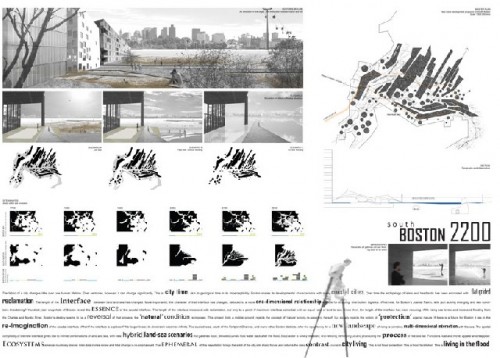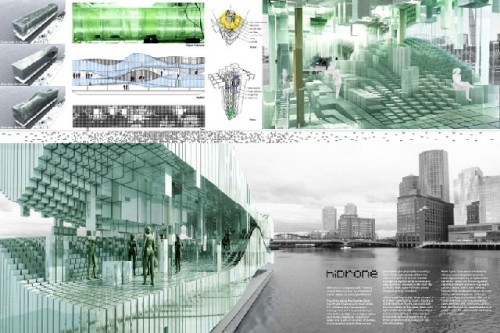SHIFTboston, A Competition of Ideas
Urban Notions, Both Thoughtful and Trivial
By: Mark Favermann - Apr 01, 2010
Architectural and design competitions can result in the good, the bad and the ugly. There is a long tradition of architectural and urban design competitions in Europe. There are many individual practitioners and firms that enter competitions as a rite of professional passage. Entering competitions is often entails unpaid but creative work. Winning these competitions is a bit of a crap-shoot. Sometimes, the losing entries are interesting portfolio pieces for younger and emerging designers while coming in second or third means less than it appears.Competitions fall into a couple of categories: Actual specific projects with exact sites and idea or concept competitions dealing with themes or large ideas. Recognition, prestige and creative experience are often as important as winning the competition prizes which in the U.S. are often more of an honorarium rather than anything substantial.
Because of the number of usually government sponsored and funded competitions a several decades ago, some small European architecture and design firms could actually make a bit of a living entering a large number of design competitions that were held throughout the continent. Today, a lot of undergraduates and graduate students enter open competitions. Specific site projects like museums or civic buildings are limited to a few invited individuals or firms. These are often further restricted to star architects or established firms.
Because of the number of usually government sponsored and funded competitions a several decades ago, some small European architecture and design firms could actually make a bit of a living entering a large number of design competitions that were held throughout the continent. Today, a lot of undergraduates and graduate students enter open competitions. Specific site projects like museums or civic buildings are limited to a few invited individuals or firms. These are often further restricted to star architects or established firms.
Late last Fall, SHIFTboston, a Boston-based nonprofit group that fosters creativity in urban design sent out a call for ideas in what it hopes to be its first annual "design inspiration" competition. About 140 architects, engineers, artists and landscape architects along with students in all of these professions submitted entries. They came from all over the world. The jury was made up of a mix of international and local-based designers and theorist/critics. In January, the finalists were announced at a presentation held at the Institute of Contemporary Art. A large interested crowd attended the presentation.
The winning proposal was Tremont Underground Theatre Space (TUTS) by architects Sapir Ng and Andrzej Zarzycki. Ng works at Tsoi/Kobus & Associates a firm that primarily designs hospital additions and laboratories. Zarzycki used to work there as well but now teaches at New Jersey Institute of Technology. Their project was to take an abandoned MBTA subway tunnel beneath Tremont Street in Downtown Boston and "shift" it into a network of underground arts venues including an experiential theatre, an interactive digital art gallery, and a museum dedicated to the oldest subway system in North America. Here was left over decaying space that could be transformed into an underground Boston cyber-experience.
Somehow, the jurors wanted to recognize a reverso High Line, the reused abandoned elevated rail line that has been transformed into an elongated park on Manhattan's West Side. This was the TUTS Team concept as well: Preservation and reuse of a decaying piece of abandoned infrastructure. This concept is subway tunnel as underground cultural space. It is taking old warehouse chic to an extreme. Underwhelming is the feeling of this prize winner. What is that old song refrain? "Is that all there is?" So this is suppose to be the best idea in a competition of wonderful strategic ideas? This design seems to be a very minor shift for Boston? The winner says perhaps more about the jurors than the quality of entries.
To give the TUTS Team some credit, they feel that this project would, like the High Line, take years to actually develop and could be built incrementally. Their notion is that this underground tunnel venue could have a great economic impact stimulating surrounding businesses, attracting tourists and residences, as well as focusing attention on new art forms. Yet, somehow, this project does not suggest a great future shift for Boston.
There were two runner-ups. One is Upside Down Radiant City by M. Liu and E. Doolittle from Quincy, MA. Their concept was to turn Le Corbusier's Radiant City and turn it upside down in Boston Harbor. The top would be a flat plain that would be transformed into a Boston Central Park. There would be playgrounds, meadows, and urban wilds that would be crisscrossed with paths with an overlay of linking neighborhood streets. Underneath would hang a new city neighborhood. This urban structure would be supported by "seascrapers" reaching and connecting to the sea floor of the city's now underused harbor. This is stylish urban futurism.
The second runner-up is The Wall as Infrastructure by U. Na and S.R. Yoo of New York City. The site chosen is isolated by both geography, the highway, and socially from residents by the Suffolk County Jail. The proposal seeks to turn a negative urban environment into ecological, economic and social opportunities. The nearly 300 foot wall of the House of Correction is targeted as a specific site for a vertical landscape for an urban farm, farmer's market, and playground.
According to the submission, this project has the potential to reactivate, revitalize and connect the community. Through vertical wall farming, the designers suggest that both the residents and those incarcerated would be able to have locally grown organic foods, exchange knowledge of cultivation and communicate more openly. It would give prisoners needed motivation and skills. This project seems rather silly and farfetched in social terms, but in relationship to forgotten and deserted or underused spaces, there is a bit of resonance. Did the jurors really think about this proposition or just like the drawing?
The Honorable Mention was given to What the Hell is That? by M.
Jull and L. Cho of Rotterdam, The Netherlands. This project deals with the difficult Boston City Hall dilemma, brutal is a beast syndrome. What the Hell is That? is actually a misquote. The real quote came from the then Mayor Collins who asked, "What the Fuck is That?" when he first saw the winning Boston City Hall proposal in 1962.
This is a highly intellectualized proposal to somehow merge conservative government with architectural notions of image transformation through more positive associations, replication, iconography and information. It is a proposal for a positive makeover campaign of the negative aspects of Brutalism architecture as symbolized by Boston City Hall. Their concept is to alter the public's perception of the structure as part of a changing Boston urban landscape.
Is this mostly words project a philosophical, social/psychological exercise in futility or an acknowledgement of changeable and sometimes trendy architectural fashion? Perhaps, it is both. This project is an academic exercise in polemics.
This is a highly intellectualized proposal to somehow merge conservative government with architectural notions of image transformation through more positive associations, replication, iconography and information. It is a proposal for a positive makeover campaign of the negative aspects of Brutalism architecture as symbolized by Boston City Hall. Their concept is to alter the public's perception of the structure as part of a changing Boston urban landscape.
Is this mostly words project a philosophical, social/psychological exercise in futility or an acknowledgement of changeable and sometimes trendy architectural fashion? Perhaps, it is both. This project is an academic exercise in polemics.
The other finalists ranged from the thoughtful to the absurd. Particularly trivial and civically totally disconnected was the proposal Walking on Water, Re-Imagining the Boston Marathon by J. Mitchell and B. Schuck, two more Tsoi/Kobus & Associates staff. Even its title is wrong: the Boston Marathon is a run not a walk.
The premise here is since historically a significant part of the City of Boston was previously submerged (about 20%), the venerable Boston Marathon should be reconfigured to reflect this. What? Are they kidding? The Boston Marathon predates the 1896 first modern Olympics by one year. Its course is sacrosanct. All marathons are based upon it. Its start line, hills, turns and finish line are part of Boston myth and legend. This is a holy shrine to distance running in particular and sport in general, both in Boston, nationally and internationally.
The premise here is since historically a significant part of the City of Boston was previously submerged (about 20%), the venerable Boston Marathon should be reconfigured to reflect this. What? Are they kidding? The Boston Marathon predates the 1896 first modern Olympics by one year. Its course is sacrosanct. All marathons are based upon it. Its start line, hills, turns and finish line are part of Boston myth and legend. This is a holy shrine to distance running in particular and sport in general, both in Boston, nationally and internationally.
The designers want the New Marathon to start at the historic core of the City and weave through the narrow streets and then access some sort of floating boardwalk to visit the now mostly desolate Harbor Islands. The finish line will be near the start line creating a loop. This proposal is not only ill-conceived but does not have any contextual idea about sports or Boston's traditions, folkways or ethos. It is embarrassing for the designers and the jurors!
Three other finalists demonstrated creative thinking. Barging through Boston: Mobile Parks on the Waterfront, Make Meet, Share and Everything In-between and Beantown Beanshare all have clear ideas expressed that have merit. The first utilizes barges to reinterpret Boston's underused waterfront. The big idea here is a sustainable (small carbon footprint) network of barges that literally can shift from one location to another and perform different tasks including transportation, storage and added commerce. These floating elements would be harborside shape-shifters changing the configuration and use of the waterfront as needed.
Make Meet, Share and Everything In-between wants to establish Fort Point Channel into a floating laboratory to test new approaches to cities and neighborhoods. This will be a carbon-neutral environment that will allow for a sensitive integrated and ecological Shared approach to urbanization. Beantown Beanshares imagines a network of shared, small food gardens all over greater Boston. Their concept is to pair eager hands with idle unused or underused land to increase green space and locally grown healthy food. There were certainly a few other good ideas as well in the competition not recognized by jurors. But that is often the drawback of competitions, the jurors with their own personal bias, attitudes, etc.
The overall idea or mission of SHIFTboston is fine. The results were good, bad and ugly. The jurors chose to forget the mission when they chose the winners. Where were the strategically great ideas to really shift Boston's future course? The prize winners demonstrated little movement, no strategic urban transformation, transference or noticeable shift. Few had any humor, wit or joy. The best of these were limited incremental ideas, not seismic earth plate movements. Hopefully the next SHIFTboston competition will include 21st Century transcendent city ideas, urban optimism and civic delights.
|
|











